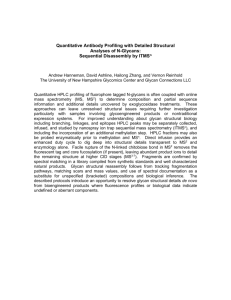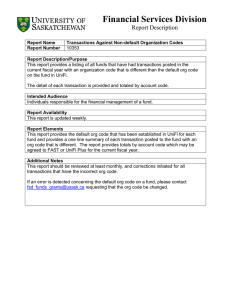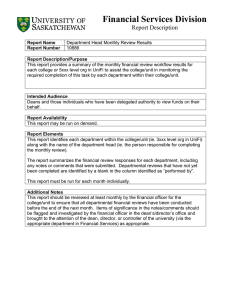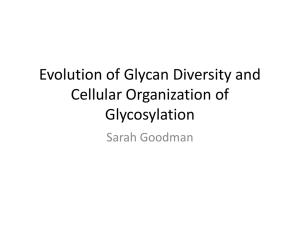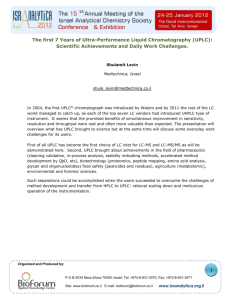A Holistic Workflow for Acquisition, Processing, and
advertisement
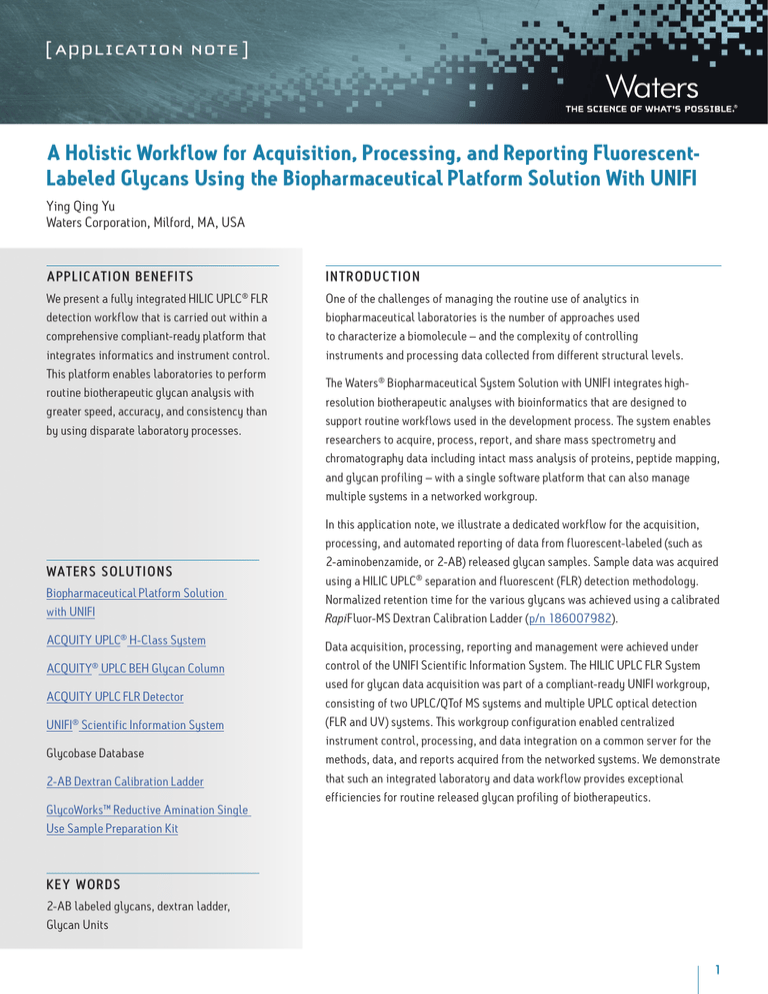
A Holistic Workflow for Acquisition, Processing, and Reporting FluorescentLabeled Glycans Using the Biopharmaceutical Platform Solution With UNIFI Ying Qing Yu Waters Corporation, Milford, MA, USA A P P L I C AT I O N B E N E F I T S INT RODUC T ION We present a fully integrated HILIC UPLC FLR detection workflow that is carried out within a comprehensive compliant-ready platform that integrates informatics and instrument control. This platform enables laboratories to perform routine biotherapeutic glycan analysis with greater speed, accuracy, and consistency than by using disparate laboratory processes. ® WAT E R S S O LU T I O N S Biopharmaceutical Platform Solution with UNIFI ACQUITY UPLC® H-Class System ACQUITY® UPLC BEH Glycan Column ACQUITY UPLC FLR Detector UNIFI ® Scientific Information System Glycobase Database 2-AB Dextran Calibration Ladder GlycoWorks™ Reductive Amination Single Use Sample Preparation Kit One of the challenges of managing the routine use of analytics in biopharmaceutical laboratories is the number of approaches used to characterize a biomolecule – and the complexity of controlling instruments and processing data collected from different structural levels. The Waters ® Biopharmaceutical System Solution with UNIFI integrates highresolution biotherapeutic analyses with bioinformatics that are designed to support routine workflows used in the development process. The system enables researchers to acquire, process, report, and share mass spectrometry and chromatography data including intact mass analysis of proteins, peptide mapping, and glycan profiling – with a single software platform that can also manage multiple systems in a networked workgroup. In this application note, we illustrate a dedicated workflow for the acquisition, processing, and automated reporting of data from fluorescent-labeled (such as 2-aminobenzamide, or 2-AB) released glycan samples. Sample data was acquired using a HILIC UPLC ® separation and fluorescent (FLR) detection methodology. Normalized retention time for the various glycans was achieved using a calibrated RapiFluor-MS Dextran Calibration Ladder (p/n 186007982). Data acquisition, processing, reporting and management were achieved under control of the UNIFI Scientific Information System. The HILIC UPLC FLR System used for glycan data acquisition was part of a compliant-ready UNIFI workgroup, consisting of two UPLC/QTof MS systems and multiple UPLC optical detection (FLR and UV) systems. This workgroup configuration enabled centralized instrument control, processing, and data integration on a common server for the methods, data, and reports acquired from the networked systems. We demonstrate that such an integrated laboratory and data workflow provides exceptional efficiencies for routine released glycan profiling of biotherapeutics. KEY WORDS 2-AB labeled glycans, dextran ladder, Glycan Units 1 E X P E R IM E N TA L LC conditions UPLC HILIC LC gradient table System: ACQUITY UPLC H-Class System Column: ACQUITY UPLC Glycan BEH Amide Column, 130Å, 1.7 µm, 2.1 mm x 150 mm (p/n 186004742) Column temp.: 40 °C Mobile phase A: 50 mM ammonium formate (pH 4.4) Mobile phase B: Acetonitrile Informatics UNIFI Scientific Information System FLR settings Biopharmaceutical Platform Solution with UNIFI ■■ ACQUITY UPLC H-Class System ■■ ACQUITY UPLC BEH Glycan Column ■■ ACQUITY UPLC FLR Detector ■■ UNIFI Scientific Information System ■■ 2-AB Dextran Calibration Ladder (p/n 186006841) ■■ GlycoWorks Reductive Amination Single Use Sample Preparation Kit (p/n 176003119) Sample preparation The 2-AB Dextran Calibration Ladder (p/n 186006841) and the GlycoWorks Reductive Amination Single Use Sample Preparation Kit (p/n 176003119) are glycan standards available from the Waters Corporation. The dextran ladder is used to calibrate and normalize labeled glycan retention times for exceptional day-to-day, system-to-system, and lab-lab reproducibility. The retention time for polyglucose 4–12 peaks were used to produce a fifth order polynomial calibration curve (Glucose Unit or GU vs. Retention Time). All analyte peaks are reported and searched using this calibrated GU value. A Holistic Workflow for Acquisition, Processing, and Reporting Fluorescent-Labeled Glycans 2 R E S U LT S A N D D I S C U S S I O N Workflow for routine released glycan determination The majority of the therapeutic proteins are glycosylated, and the attached glycans have significant impact on the efficacy and safety of the biotherapeutic. The International Conference on Harmonization Guideline Q6B requires the analysis of carbohydrate content, structural profiles, and characterization of the glycosylation site(s) within the polypeptide chain(s). The most widely adopted analytical workflow for routine N-linked glycan characterization involves labeling the enzymatically released glycans with a fluorescent tag (typically 2-aminobenzamide, or 2-AB), resolving the labeled glycans by hydrophilic interaction liquid chromatography (HILIC UPLC), and detecting the labeled glycan peaks with a fluorescence detector. The assignment of glycan peaks during routine analysis is fundamentally based on matching their retention time to established values. For non-routine analysis, glycosidase arrays or MS analysis are employed to give tentative assignments or resolve ambiguous peak assignments. In order to best control method variation (between runs, days, instruments, scientists, and labs) glycan profiles from the HILIC separation are always calibrated and normalized against a 2-AB Dextran Calibration Ladder (glucose homopolymer). Glycan peaks in an unknown sample can be assigned a Glucose Unit (GU) value from the GU vs. Retention Time calibration curve using the dextran ladder, which is typically fitted with a fifth-order polynomial or cubic spline calibration line.1 The new streamlined workflow in UNIFI Software, v. 1.6, (Figure 1) enables users to automatically collect one or more dextran ladder standard data sets, process the chromatograms, generate dextran calibration curve, and apply curves directly to unknown samples. Assigned GU values for peaks in an unknown are searched through Glycobase 3.1+, an integrated UPLC GU released glycan database, developed by Waters in collaboration with the National Institute for Bioprocessing Research and Technology (NIBRT) (https://glycobase.nibrt.ie/glycobase/browse_glycans.action). Targeted component search is enabled within a more information-rich integration of Glycobase in the next version of UNIFI Software, v. 1.6.1. The integrated Glycobase database will reference hundreds of glycan GU entries along with supporting structural, mass, and exoglycosidase digestion pathway information. A Holistic Workflow for Acquisition, Processing, and Reporting Fluorescent-Labeled Glycans 3 Figure 1. Glycan analysis workflow. A) 2-AB Dextran Calibration Ladder was used as a separation standard. B) The Glucose Unit (4-12) calibration from the separation standard was fitted by a fifth order polynomial curve. C) Glycan peaks from an unknown sample were assigned GU values from this curve. The measured GU value was searched using the Glycobase entries to assign structures from GU values. A Holistic Workflow for Acquisition, Processing, and Reporting Fluorescent-Labeled Glycans 4 UNIFI method generation Figure 2 depicts the key elements of producing an automated and holistic glycan acquisition, processing, and reporting method within UNIFI. The instrument settings define the instrument modules required for the analysis, and define method parameters for HILIC UPLC separation and fluorescence detection. The processing setting defines peak integration and dextran ladder calibration settings. A comprehensive report can be generated automatically following acquisition and processing using one or more report templates that can be readily modified. Modifications to the processing and reporting settings within the method are possible post-acquisition, and are audit trailed for simplified documentation and compliance purposes. Figure 2. The UNIFI released glycan analysis method. A Holistic Workflow for Acquisition, Processing, and Reporting Fluorescent-Labeled Glycans 5 Figures 3 through 5 detail how a scientist can use UNIFI Software to navigate through processed and raw chromatographic results. A typical dextran calibration curve shown in Figure 3 is applied to the GlycoWorks Reductive Amination Single Use Sample Preparation Kit (p/n 176003119), a mixture of N-glycans from mAb (Figure 4). Reproducibility of the results is depicted in Figure 5. The ability of UNIFI to automatically summarize data from multiple injections of standards and unknown samples is highlighted in these displays. Figure 3. In UNIFI Software, the review panel summarizes GU values (GU 4–12) obtained across 5 injections of the 2-AB Dextran Calibration Ladder standard. The chromatogram of the first injection and calibration curve results for all injections are displayed below the summary table. Figure 4. A component summary table in the review page that compares the GU value for all the identified glycans across a triplicate injection of a glycan mixture sample. Summary calculations for individual glycans across triplicate analysis of the glycan test standard are presented in the component summary table. A Holistic Workflow for Acquisition, Processing, and Reporting Fluorescent-Labeled Glycans 6 Figure 5. The Investigate panel of the experiment demonstrates glycan profile reproducibility for five HILIC UPLC FLR analyses of the glycan mixture. Figure 6 provides a snapshot of a typical glycan analysis report; information such as the sample list, retention time calibration curve fitting for 2-AB Dextran Calibration Ladder, and calculated GU values for unknown glycan samples are organized within single report template. Valuable information such as the relative abundance and the GU value for each glycan component were also summarized with appropriate statistical analysis. Figure 6. A typical UNIFI released glycan report. A Holistic Workflow for Acquisition, Processing, and Reporting Fluorescent-Labeled Glycans 7 C O N C LU S I O N S Reference UNIFI is the first comprehensive software that seamlessly integrates UPLC chromatography, optical detection, high resolution mass spectrometry, and integrated informatics within one platform. Released glycan analysis is one of the latest application workflows to be offered in UNIFI Software, v. 1.6. 1. Campbell, M.P.; Roylez, L.; Radcliffe, C.M.; Swek, R.A.; Rudd, P.M. GlycoBase and autoGU: tools for HPLC-based glycan analysis. Bioinformatics. 2008, 24:9, 1214–1216. This new UNIFI Application Solution enables a scientist in regulated or unregulated laboratory environments to acquire, process, and report qualitative and quantitative glycan information along with high confidence and minimal user intervention. Waters, T he Science of W hat’s Possible, ACQUITY UPLC, UPLC, and UNIFI are registered trademarks of Waters Corporation. RapiFluor-MS and GlycoWorks are trademarks of Waters Corporation. All other trademarks are the property of their respective owners. ©2013–2016 Waters Corporation. Produced in the U.S.A. January 2016 720004619EN AG-PDF Waters Corporation 34 Maple Street Milford, MA 01757 U.S.A. T: 1 508 478 2000 F: 1 508 872 1990 www.waters.com
